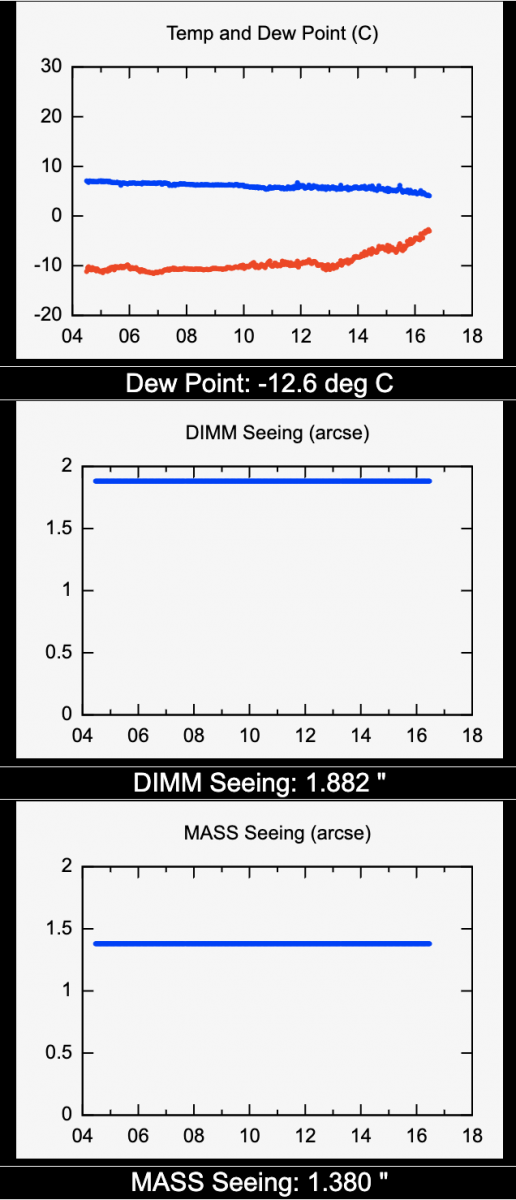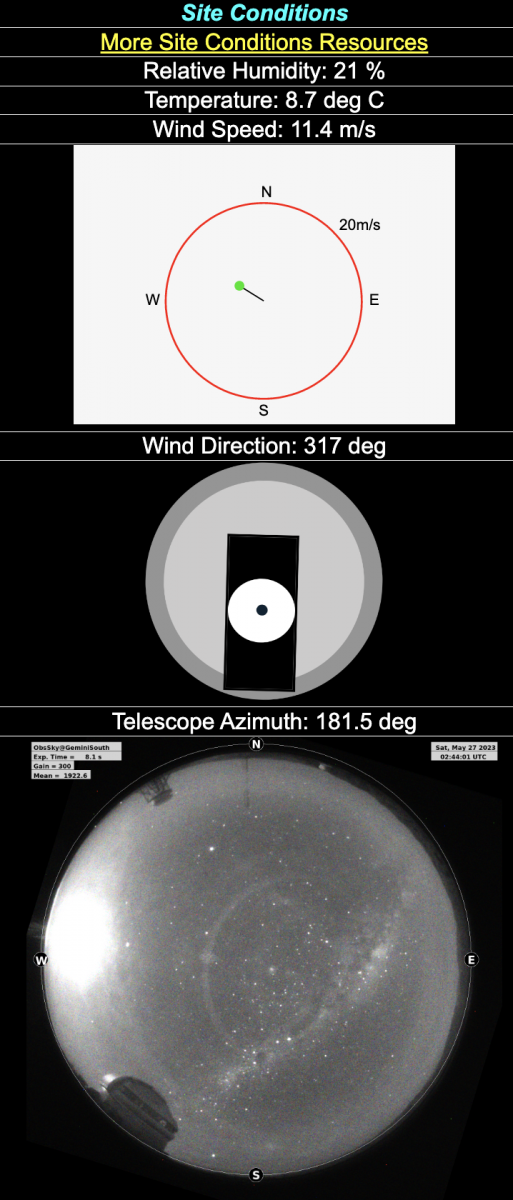Site Status
The Gemini site status pages contain information such as the operating status of the telescope, pertinent weather information, skycams at each site, and available instruments and their current configurations. These pages have recently been improved to make triggering of observations easier for Target of Opportunity (ToO) PIs during nighttime operations. Links to the pages, descriptions of the information on these pages, and how they can be used to assess target triggering are given below.


Instrument Availability, Configuration, Validity and Open Status
The ToO Availability, Instruments Availability, Comment, and Validity period for each site is populated by a Queue Coordinator at least once per week. The GMOS Config section is updated automatically, once daily. If a site is in an engineering shutdown or if the whole night is lost to poor weather, the ToO Availability and Comment sections will be updated to reflect this. In cases where weather is intermittent but the night still has potential, the Open Status updates every 5-10 minutes to reflect whether the top shutter is physically open.

Left Panel (Top to Bottom)

Gemini North
GOES Cloud Cover Animation
This animated gif features GOES 18 Band 10 satellite data processed by Gemini to best estimate cloud coverage as it pertains to the Gemini cloud cover (CC) observing constraints, along with clear air humidity.
Mauna Kea All Sky Infrared and Visible Sky Monitor
This all sky camera maintained by CFHT gives a good indication of the presence of clouds and context of their location with respect to the Gemini Cloud Cameras via the magenta annotated boxes.
Gemini East-Facing Cloud Camera
One of Gemini's multiple cloud cameras, the east facing camera typically shows the best view of incoming clouds from the perspective of the summit.
Gemini South
GOES Cloud Cover Animation
This animated gif features GOES 18 Band 10 satellite data processed by Gemini to best estimate cloud coverage as it pertains to the Gemini cloud cover (CC) observing constraints.
ESO Annotated GOES Satellite VIS & Thermal Imagery
These annotated GOES images by ESO show the location of many Chilean observatories in the context of visible and thermal imagery to estimate current and future cloud coverage.
ESO Annotated GOES Satellite Cloud Top Imagery
These annotated GOES images by ESO show the location of many Chilean observatories in the context of cloud imagery to estimate the thickness of clouds and the magnitude of weather systems.
Center Panel (Top to Bottom)
Gemini North
Site Conditions
Relative Humidity (RH), Temperature and Wind Speed are all relevant metrics for telescope operations. For example, the telescope is closed at RH >= 85%, and only opened back up if it is stable at < 75% for 40 minutes. As temperature approaches the dewpoint, RH increases. We also have operational limits for wind speed and cannot operate with sustained winds > 22 m/s or wind gusts up to 26 m/s. The shutter will be closed at much lower speeds if loose snow or dust is present.
Wind Direction and Telescope Pointing
The wind direction and telescope pointing can give more context to seeing measurements in the data. While dependent on windspeed, surrounding terrain, and the temperature differential between the dome and outside, pointing into the wind will typically produce better seeing than pointing away from the wind. Note that the DIMM and MASS seeing measurements shown in the right panel will not be affected by this, as they are measured outside of the telesope.
GOES Water Vapour
This GOES 18 Band 10 satellite imagery can give more context to measured water vapour absorption on the GN right panel and type of cloud coverage.
Gemini South
Site Conditions
Relative Humidity (RH), Temperature and Wind Speed are all relevant metrics for telescope operations. For example, the telescope is closed at RH >= 85%, and only opened back up if it is stable at < 75% for 40 minutes. As temperature approaches the dewpoint, RH increases. We also have operational limits for wind speed and cannot operate with sustained winds > 20 m/s or wind gusts up to 25 m/s. The shutter will be closed at much lower speeds if dust is present.
Wind Direction and Telescope Pointing
The wind direction and telescope pointing can give more context to seeing measurements in the data. While dependent on windspeed, surrounding terrain, and the temperature differential between the dome and outside, pointing into the wind will typically produce better seeing than pointing away from the wind. Note that the seeing measurements shown in the right panel will not be affected by this, as they are measured outside of the telesope.
Gemini South All-Sky Camera
This all sky camera gives a good indication of the presence of clouds above the observatory, and context of their location.
Right Panel (Top to Bottom)
Gemini North
CFHT Weather Tower Seeing
DIMM and MASS seeing as measured by the CFHT weather tower between CFHT and Gemini. Go here for more information on DIMM and MASS, and how to interpret these values. Note that some manually measured FWHM from Gemini data can be added to this plot and scaled by the filter of the data. The plot legend clarifies when that data is present. The horizontal lines provide a rough guide to correspond the measured data with the Gemini observation contraints.
Cloud Coverage (CFHT Skyprobe, Gemini, GOES)
Cloud coverage measurements from the CFHT skyprobe, the Gemini Quality Assurance Pipeline, and GOES are shown to estimate the current cloud coverage with respect to the Gemini observation constraints.
MaunaKea Water Vapour Opacity
Water vapour opacity measurements are displayed to estimate the amount of water vapour in the atmopshere with respect to the Gemini observation constraints.

Gemini South
Temperature and Dewpoint
The temperatures are typically higher at the summit for GS than GN, and this can lead to potential technical issues if the dewpoint rises above the operating temperatures of the cooling lines for the hardware. Thus, the dewpoint is monitored closely at GS for reasons beyond high RH.
DIMM Seeing
DIMM seeing measurements provided by the Gemini South Environemental Monitor. Go here for more information on DIMM and MASS, and how to interpret these values.
MASS Seeing
MASS seeing measurements provided by the Gemini South Environemental Monitor. Go here for more information on DIMM and MASS, and how to interpret these values.



